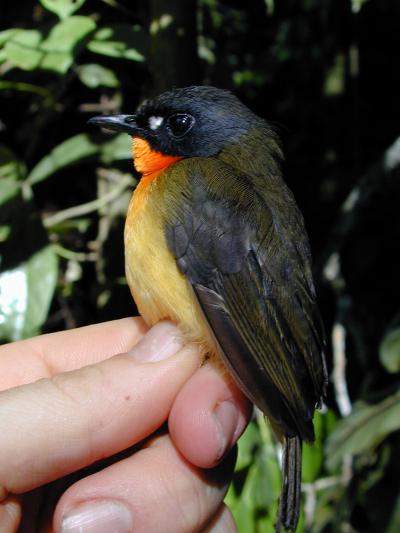- Forest robin
Taxobox
name = Forest robin

image_caption = "Stiphrornis pyrrholaemus "
regnum =Animal ia
phylum = Chordata
classis = Aves
ordo =Passeriformes
familia =Muscicapidae
genus = "Stiphrornis"
genus_authority = Hartlaub,1855
subdivision_ranks =Species
subdivision = "1-5, see text"The forest robins are small Central and
West Africa nbird s from thegenus "Stiphrornis". They have been placed in the familyTurdidae , but are now generally placed inMuscicapidae in the group popularly known as chats. Traditionally, only a single species, the Forest Robin ("S. erythrothorax"), has been recognized, but recent reviews have recommended recognizing 5 species. All have a total length of around 12 cm (4½ in), have dark upperparts, and a throat and chest that, depending on the exact species, is yellow-orange or deep orange.Collar, N. (2005). Forest Robin (Stiphrornis erythrothorax). Pp. 730-731 in: del Hoyo, J., Elliott, A., & Christie, D. eds. (2005). "Handbook of the Birds of the World." Vol. 10. Cuckoo-shrikes to Thrushes. Lynx Edicions, Barcelona. ISBN 84-87334-72-5]Taxonomy
The initial split into multiple species within this genus is based on a review from 1999 where it, based on the
phylogenetic species concept , was argued that all then recognizedtaxa should be consideredmonotypic species.Beresford, P. & Cracraft, J. (1999). "Speciation in African forest robins (Stiphrornis): species limits, phylogenetic relationships, and molecular biogeography." American Museum Novitates 3270: 1–22. [http://digitallibrary.amnh.org/dspace/bitstream/2246/3048/1/N3270.pdf PDF available.] ] Of these, "S. gabonensis" and "S. xanthogaster" were formerly considered subspecies of "S. erythrothorax", whereas "S. saghensis" was described as an entirely new species. The split was not followed inHandbook of the Birds of the World , where described as "perhaps premature". Comparably, the BirdLife Taxonomic Working Group (and consequentlyIUCN ) recommended not following the split, as differences inplumage s are relatively small, genetic sampling considered incomplete, and evidence forintergradation orparapatry is lacking.IUCN2006|assessors=BirdLife International|year=2006|id=51729|title=Stiphrornis erythrothorax |downloaded=27 September 2008 Database entry includes justification for why this species is least concern.] Another species from this complex, "S. pyrrholaemus", was described as a new species in 2008. Based onmtDNA , it is placed within "S. erythrothoraxsensu lato ", and consequently is only a species (rather than a subspecies of "S. erythrothorax") if at least some of thetaxonomy recommended in 1999 is followed.Schmidt, B., Foster, J., Angehr, G., Durrant, K., & Fleischer, R. (2008): "A new species of African Forest Robin from Gabon (Passeriformes: Muscicapidae: Stiphrornis)." Zootaxa 1850: 27–42. [http://www.mapress.com/zootaxa/2008/f/zt01850p042.pdf PDF available.] ] Thegenetic divergence between "S. pyrrholaemus" and other members of the genus is comparably to that between some other closely related species.pecies
*
Western Forest Robin ("Stiphrornis erythrothorax").
*Olive-backed Forest Robin ("Stiphrornis pyrrholaemus").
*Gabon Forest Robin ("Stiphrornis gabonensis").
*Sangha Forest Robin ("Stiphrornis sanghornis").
*Eastern Forest Robin ("Stiphrornis xanthogaster").References
Wikimedia Foundation. 2010.
